While the V&A’s blockbuster Alice in Wonderland exhibition has been delayed until next year, people will be able to experience the fantasy world thanks to virtual reality (VR).
London-based games studio Preloaded has collaborated with HTC Vive Arts and the V&A on three VR set pieces ahead of Alice: Curiouser and Curiouser, which opens March 2021.
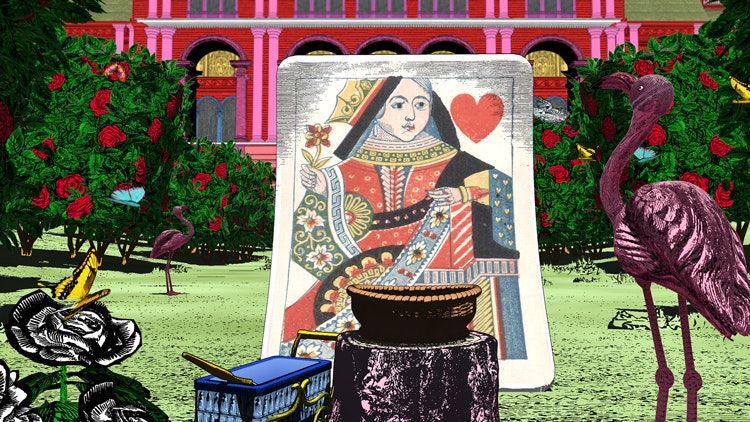
The exhibition, which was supposed to open this summer, explores Alice’s Adventure in Wonderland since Lewis Carroll’s manuscript was written 157 years ago.
On display will be photographs of Alice Liddell (Carroll’s alleged inspiration for the eponymous character), illustrator Ralph Steadman’s modern interpretations of the characters as well as elaborate costumes from a 2011 Royal Ballet production.
There will be a live VR event on 22 October – a first of its kind for the museum – which will act as a “teaser” for the exhibition, Preloaded associate creative director Jon Caplin tells Design Week. For this event, people will be able to tune in without a headset.
The 45-minute event will recreate the V&A’s entrance hall and feature objects from the exhibition. People will be able to move about freely as the exhibition’s curator Kate Bailey speaks, taking visitors through some of the exhibition highlights.
The event will feature some of the visuals from the fictional world, such as the Pool of Tears and Hallway of Doors, Caplin says, while the space will be “filled and dressed” in the exhibition’s fantastical style, he adds.
Bringing wonderland to life
Work between Preloaded and the V&A began late last year. The original plan was to have a 4-minute VR experience at the exhibition itself, although this has been expanded. The extended at-home VR experience Curious Alice will be available to download on Viveport from 22 October.
The exhibition experience features two “levels”, Caplin explains. Using headsets, people will be able to explore the Hall of Doors (which plays with ideas of scale). Participants will then be led into the queen’s garden where they can take part in a “curious game of croquet”.
There is “hand-tracking technology” so that users can pick up hedgehogs and throw them at hoops which are made of cards, closely mirroring a scene from the book itself, according to Caplin. This makes the Queen of Hearts more and more agitated, and when she shouts “off with her head”, the player will be surrounded by a house of cards.
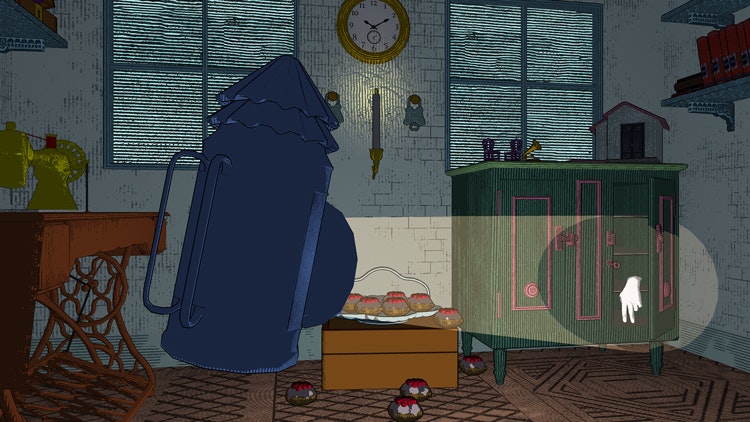
The experience is aimed at people aged 15 years old and above and needed to be “instantly understandable” to users. This is partly achieved by matching the world’s visuals to the exhibition, Caplin says.
Icelandic artist Kristjana S. Williams had created the illustrations for the exhibition publication, and these provided the aesthetics for the VR work. Her vintage-style illustrations were based on 19th century paper peep shows – miniature worlds that sought to transport people to faraway lands or theatre sets.
Caplin explains that these had to be layered to give the virtual world “depth”. The design team looked for objects such as carriage clocks and “remodelled” and “retextured” them.
The finished visuals have “etching lines” which fit in with the illustrative style and turn the flat drawings into three-dimensional worlds. A careful consideration to light and dark was also important, the designer says.
“We tried to get her illustrations to come to life rather than steer away from them,” he adds. The overall process took around six months.
“It freed us, from a creative point of view”
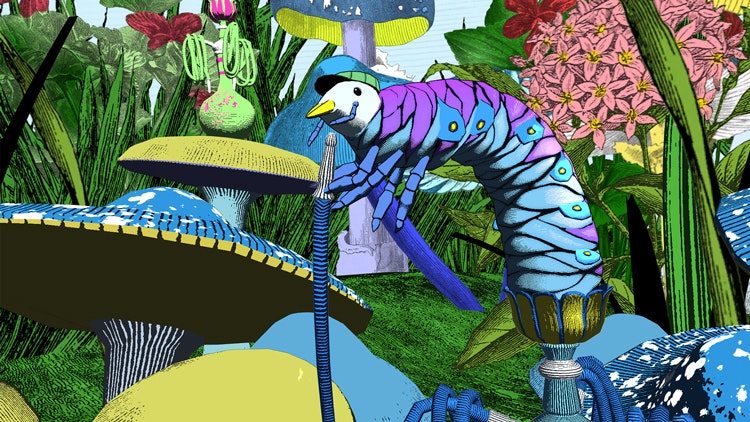
Two more “chapters” have been created for the at-home version. These include a treasure hunt in the White Rabbit’s house where users will be looking for an animated glove. The interiors are lit up by a lantern, which shines light on the fantastical world. There’s also a riddle-solving level where players have to spar with the Caterpillar in a field of mushrooms.
“From a creative point of view it freed us,” Caplin says. “We could do anything.” The “triptych” aims to engage with different skills but also explore themes relevant to the exhibition.
The Queen of Heart’s croquet match is all about “defying authority” while the White Rabbit’s house explores ideas of growing up – emphasised by the ticking clock. The Caterpillar’s section is a “mental” challenge and the team used five riddles from Carroll’s other works to develop this setpiece.
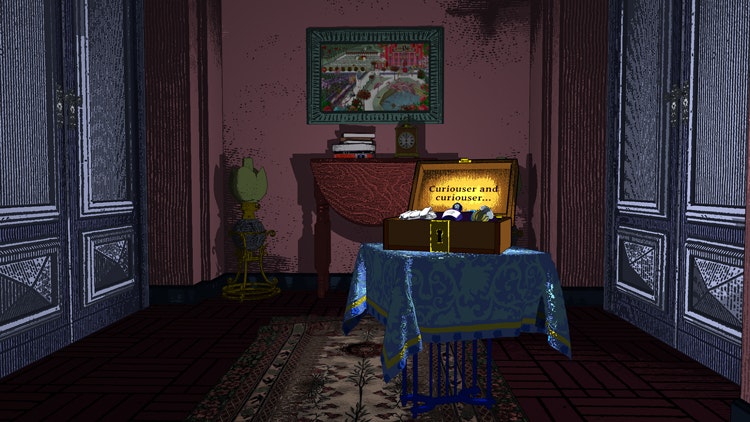
“You can change the environment completely”
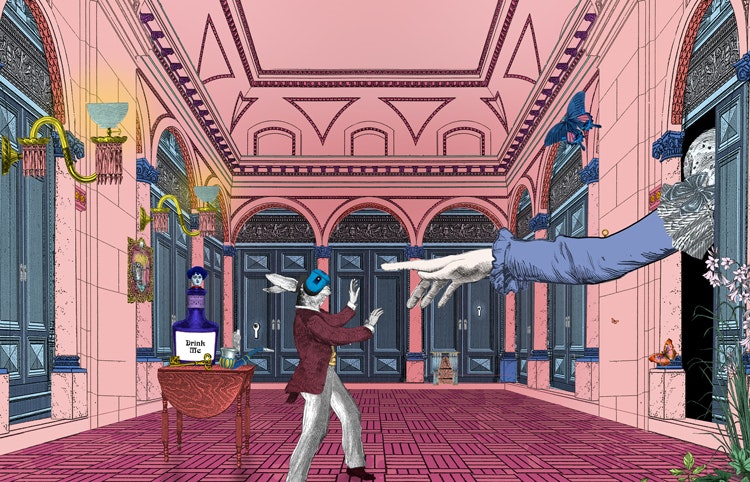
The expansion into a domestic setting also opened up the possibilities for exploration, Caplin says. There were no spatial or time constraints which allowed the team to develop a more playful experience. He likens it to television gameshow Crystal Maze.
VR complements the “warped” world of Carroll’s books, Caplin says. “Not being held back by the physical world means you can change the environment completely, in colour and scale.” For example, players enter the world by reaching for a floating book. The ground then opens beneath their feet as they tumble down the rabbit hole.

He hopes that the technology will add a new dimension to the well-worn Wonderland universe. There have been many books, films and videogames based on Carroll’s original novel. Caplin says that VR puts people “front-and-centre” as Alice for the first time.
When she’s drinking a potion that makes her shrink or eating a mushroom that turns the world psychedelic, it’s really the participant who’s “in the middle of it”, he says. The ability for VR to play with scale works especially well for Alice’s adventures.
Thematic music has been commissioned for each chapter as well as sounds that bring the world to life such as rustling leaves and ticking clocks. Quotations from the novel have been interwoven as a way to incorporate the platform’s literary roots.
Caplin adds that you have to be careful when designing these experiences so that people don’t just end up feeling sick. As people fall down the rabbit hole, there are props for the story – like books and cabinets – which “anchor” them, for instance.
How museums have coped with lockdown
During lockdown, galleries and museums have had to find creative ways to reach people at home, from digitization of archives to AR apps.
While the easing of lockdown has meant that more institutions have been able to open – like the Design Museum’s electronic music exhibition and the Imperial War Museum’s show on refugees – there are still limitations set by social-distancing and fewer interactive features (if any).
VR could offer new opportunities for this field, Caplin believes, though this would require people to buy their own headsets. The Alice: Curiouser and Curiouser platform requires the equipment. He points out that these have come down in price since they were first launched.
Elsewhere, there have been inventive uses of technology. To coincide with Electronic: From Kraftwerk to The Chemical Brothers, Pentagram’s Yuri Suzuki and electronic music company Roland launched an online creation platform which emulates the sounds from Roland’s cult drum machine and bass synthesiser.

- Design disciplines in this article
- Industries in this article
- Brands in this article






